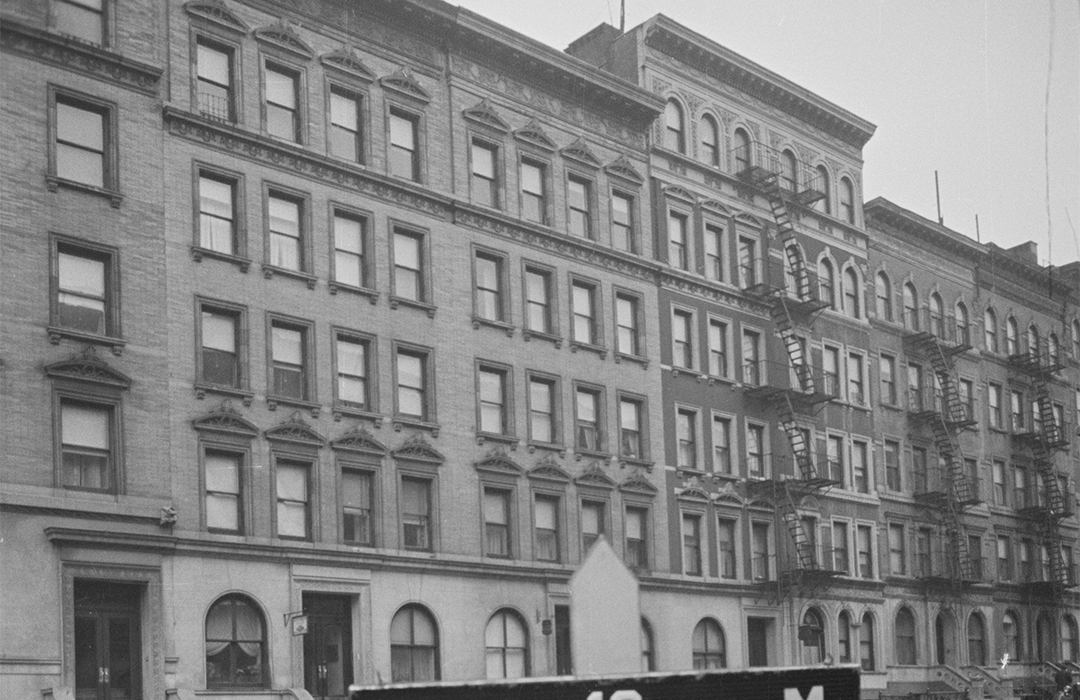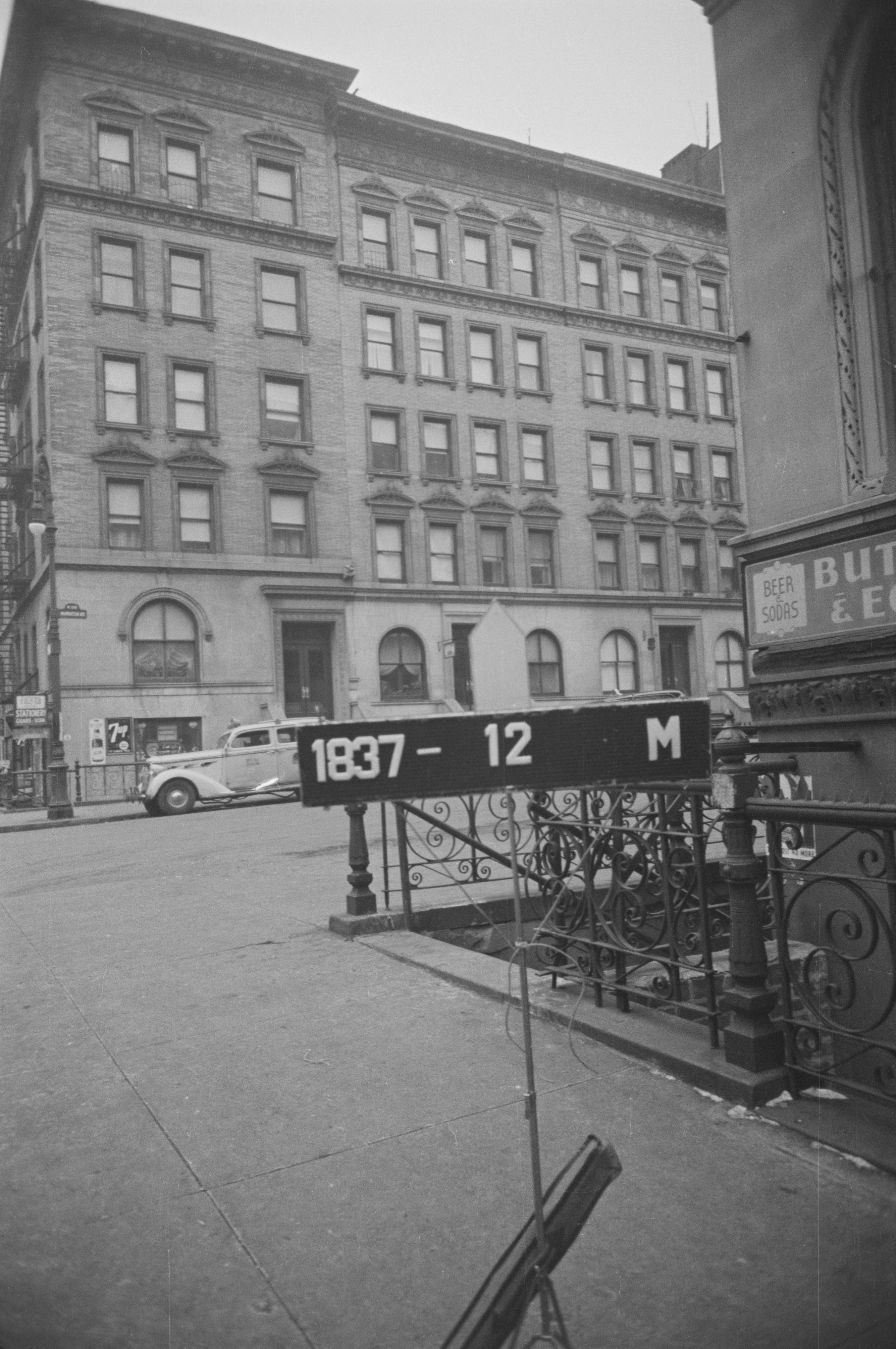
23 + 25 Manhattan Ave.
by Tom Miller
In 1896, architects Herbert Spencer Styne-Harde and James E. Ware partnered to design four five-story flat buildings at 21 through 27 Manhattan Avenue for real estate developer William Walsh. The two identical middle structures (Nos. 23 and 25) cost Walsh $24,000 each to construct, or about $925,000 in 2025 terms. Their tripartite, Italian Renaissance design included stone bases with centered entrances flanked by fully arched windows. The three-story, brick-faced mid-sections sat between molded intermediate cornices. The second- and fifth-floor windows wore arched terra cotta pediments containing a wreath and swags. Each was topped with an ornate palmette.
An advertisement in The New York Sun in 1899 said 23 and 25 Manhattan Avenue offered “elegant apartments of 6 and 7 extra large, light rooms and bath, steam heat, hot water supply, oak woodwork, open nickel plumbing; rents $30 to $36.” The highest rent would translate to $1,400 per month today.
The tenants were middle and upper-middle class and had diverse professions. Among the residents of 25 Manhattan Avenue in 1898, for instance, were Mahlor Chance (“who writes for a living,” according to the New York Journal and Advertiser) and William H. Murphy, a furniture delivery driver. The names of both landed in the newspapers that year.
In July 1898, Mahlor Chance read about the sinking of the luxury steamship La Bourgogne off Newfoundland. Among the fatalities listed were Edith Patten and “Mrs. Parcello.” Chance knew that Edith Patten, an artist, had a studio in Carnegie Hall, as did operatic soprano Marie Parcello. The New York Journal and Advertiser said, “It was natural to suppose that they had sailed together, and so Mr. Chance told the reporters.” Newspapers—as far as Paris—picked up the story of the two deceased artists. “Upon receiving news of the death of Miss Parcello, all the relatives of the young woman went into a decline,” said The New York Journal and Advertiser.
The first of the two women to be found quite alive was Edith Patten. It was discovered that she had not sailed on the ship as reported. And Marie Parcello—who was “Miss Parcello” rather than “Mrs. Parcello,” had been off on a “yachting trip.” The New York Journal and Advertiser wrote, “Miss Parcello is back in New York, fair and saucy with the brown of the sea breeze on her face and the flush of vengeance in her eye. She is trying to find out how she was dead when she was alive.” She quickly traced the rumor of her demise to Mahlor Chance. She stormed to his Manhattan Avenue apartment where, according to the article, he “succeeded in explaining that he was innocent, and Miss Parcello is on the war path.”
“Miss Parcello is back in New York, fair and saucy with the brown of the sea breeze on her face and the flush of vengeance in her eye. She is trying to find out how she was dead when she was alive.”
On December 1 that year, William H. Murphy backed up his furniture wagon to an apartment building on 109th Street. He went upstairs and began “dickering with a woman about moving some furniture,” said The Sun. In the meantime, the front wheels of his wagon were between the rails of the uptown Lenox Avenue electric streetcar line. The first conductor to arrive got out and searched for the driver. He found him, but Murphy and the woman were in a heated battle, and he refused to move the wagon. One by one, irate conductors arrived at the apartment until finally, they convinced Murphy to come down. The Sun reported that by then, “there was a string of thirteen cars waiting to go uptown and…there were as many more cars blocked on the downtown track.” Murphy was arrested for “needlessly interfering with street car traffic.”
The Forsyth family occupied an apartment next door at 23 Manhattan Avenue at the time. Jennie Forsyth, who was 17 years old, fell madly in love with Frederick Kolb, who was 19. Her parents refused to allow the teenager to get married, and it was too much for her broken heart to bear. On January 1, 1899, The New York Times reported that the previous day, Jennie “attempted to commit suicide by swallowing carbolic acid at her home, 23 Manhattan Avenue.” She was taken to the J. Hood Wright Memorial Hospital, where she recovered.
In the summer of 1901, residents of Manhattan Avenue were plagued with burglaries, including the apartment of Harry L. Hunt on June 30. Hunt later said, “The robberies are awful up my way. Everybody’s buying pistols. I bought one myself today.” He said, ‘I lost jewelry and silverware and clothing, and a nice new grip that they used to take it way.”
On August 8, Harry Hunt testified before a committee of the State Assembly investigating police incompetence. He said he never expected to get his stolen items back. “In the first place,” he testified, “when I went around with an officer he went through the flat with me, and he asked the sergeant if it was necessary to make a report, and the sergeant said, no, it was not necessary.” Additionally, Hunt told them that the janitress of the building had seen the burglars clearly, but they did not bother to interview her.
Harry Hunt and his fellow residents would have another problem two months later. The building had been purchased in 1899 by Robert Harris. “Shortly after purchasing it, he became ill and was sent to Ward’s Island,” explained The New York Times. The Sun added that he, “is now in an insane asylum.” In November 1901, the bank foreclosed, and it was purchased by Robert Rankin. He went to each tenant, introducing himself and telling them that they owed December’s rent. But the residents had already paid the rent to the former owner’s sister and refused to double-pay.
Rankin, they quickly discovered, was a no-nonsense (and cold-hearted) businessman. On December 6, the tenants received dispossess notices, and at dusk that day, he cut off the water, the steam heat, and the gas. On December 8, The Sun reported, “some of them say their experiences were akin to the hardships of Polar explorers.” The New York Times called it a “pitiable plight.” Everett Corney, “whose mother is suffering with pneumonia,” according to the newspaper, began legal proceedings against their new landlord.
John Carey, who worked as a plasterer, his wife, and their widowed daughter occupied an apartment at 25 Manhattan Avenue in 1902. On the night of New Year’s Eve that year, Policeman Fry heard “cries of murder” coming from the Carey apartment. In court the next day, he said “when he went there he found Mrs. Carey bleeding from a wound in the head and the daughter, Mrs. Clark, unconscious on the floor. Carey was drunk.”
The next day, January 1, 1903, Carey was called before Magistrate Matthew J. Breen—the magistrate’s first day on the bench. The Evening World reported that Breen, “showed himself sympathetic in most cases, but he gave all wife beaters warning of what they must expect from him when he got to the case of John Carey.” After listening to Officer Fry’s testimony, Breen asked Carey what he had to say.
The Evening World reported, “’I don’t remember nuttin’ about it,’ answered Carey, surily.”
Carey was sentenced to six months in the Penitentiary and Workhouse on Blackwell’s Island.
Among the residents of 23 Manhattan Avenue in 1903 were Cecil James, a tenor who advertised himself as available for “oratorio, concert, recital” work; and Cecil Thomas, the chief electrician at the New York Herald. Thomas was an associate member of the American Institute of Electrical Engineers.
Another resident of 25 Manhattan Avenue to land behind bars was 18-year-old William Tinan. On August 25, 1907, he and two other teenagers went to Harry Horowitz’s restaurant on Eighth Avenue. They had already concocted a scheme to get free lunch. The New York Times said each of them “ate something like four servings of ham and eggs before they decided on a halt for the dessert.” They asked the waitress, Ella Cohen, “Bring us some lilac pie.” She told them that there was no such thing as lilac pie.
Tinan and his cohorts began beating Horowitz mercilessly and slathering him with blueberry and currant pies.
Ella Cohan later said that they demanded, “Bring lilac pies or you get no pay.” She told Horowitz, but she “had hardly done so before the three were at him.” Tinan and his cohorts began beating Horowitz mercilessly and slathering him with blueberry and currant pies. Ella ran to the sidewalk crying, “Police! Fires! Murder! Police! Help!” according to The Times. “A Harlem crowd quickly gathered,” said the article. When the trio burst out of the restaurant, the crowd followed. The New-York Tribune reported, “They were chased for several blocks, but Tinan was the only one caught.” The angry mob took him to the West 125th Street station where he was booked with disorderly conduct.
William J. Thompson left his mother, Anna Thompson, and his three unmarried sisters at 23 Manhattan Avenue to fight in World War I. He and another New Yorker, Sergeant Edward J. Hussey, were killed in the battle of Argonne on October 28, 1918. Three years later, both bodies were returned to New York and on September 22, 1921, a double military funeral was held in St. Peter’s Church on Staten Island.
Twenty-one-year-old Joseph Clancy, who lived at 25 Manhattan Avenue, was arrested on September 15, 1921, for robbery. He and his accomplices used a girl in their armed robberies. The New York Times explained that she carried their firearms in a candy box. “When they needed them, she handed them over. After the shooting, she concealed them under the candy again and walked away in a different direction from the men.” Should the robbers be captured, they would have no weapons on them. Clancy’s luck ran out, however, and he was held at $5,000 bail—a significant $87,500 today.
Narcisco Rios was arrested for a very different crime on July 6, 1943. The 50-year-old, who lived at 23 Manhattan Avenue, worked as a longshoreman. He and two others were “found guilty of smoking in the hold of a ship docked at Pier D” in Jersey City,” as reported by The New York Times. They were sentenced to ninety days in jail. Somewhat surprisingly, it was not the act of smoking that got them in trouble—it was how they lit those cigarettes. The article explained, the ordinance under which they were jailed prohibited “the carrying of safety matches along with other inflammable materials” on the docks.
The end of the line for the two handsome buildings came after the midcentury. They were demolished to make way for the massive Frederick Douglass Houses project, completed in 1958.
Tom Miller is a social historian and blogger at daytoninmanhattan.blogspot.com



